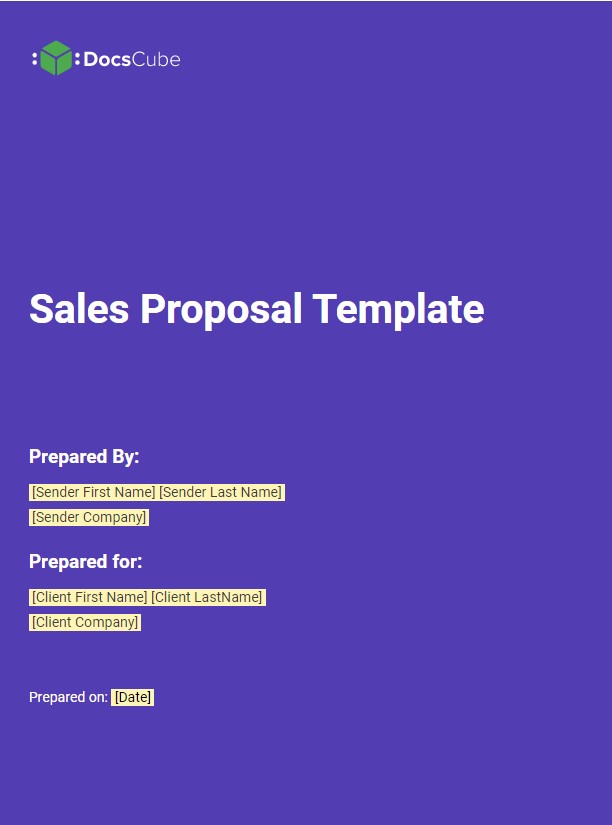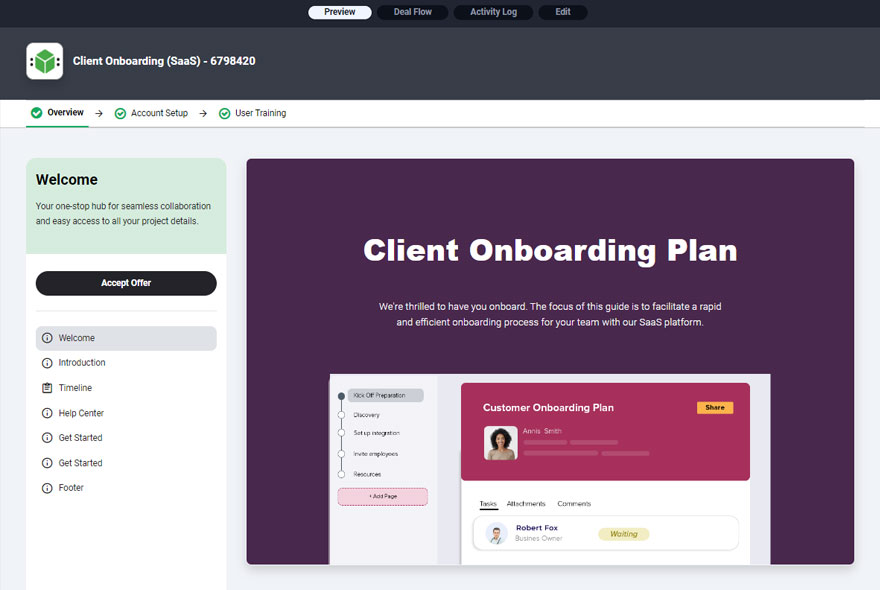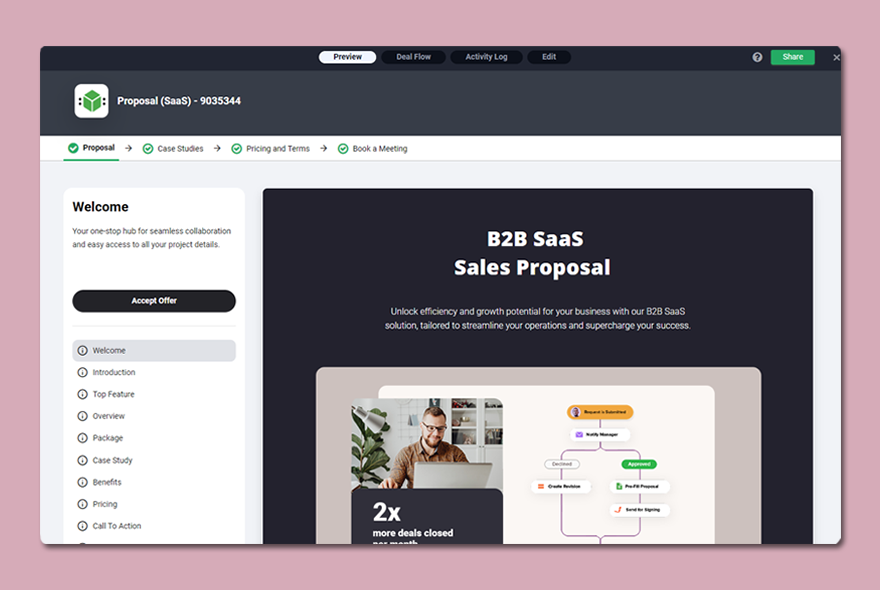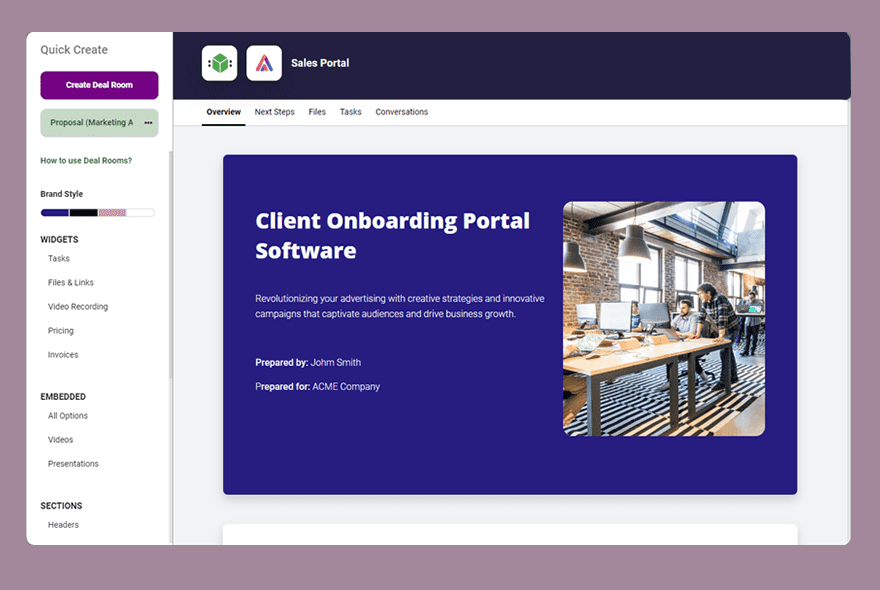Ready to create your perfect sales proposal?
You have developed your project/product or service and are ready to pitch it to your prospective client. In this article you can find method how to write sales proposal.
You are convinced your offer is the ideal fit, but how do you convince your prospect to purchase?
You write the perfect sales proposal – a strategy that makes your client feel heard, solves their problem and overcomes their hesitation in purchasing.
Sales proposals are an essential feature in closing a deal.
Too often, businesses overlook the importance of these documents and don’t utilize them to their full potential. The result? Lost opportunities and vital connections.
To help you lock in that deal and feel more comfortable asking for the sale, DocsCube has outlined the perfect how to write sales proposal strategy.
Follow the steps below, close more deals and improve your sales game.
Learn How to Write Sales Proposal!
A sales proposal is a document of about 10-20 pages outlining your services to a prospective client. The proposal is essentially an outline which presents the client’s problem, the deliverables, benefits of your services and costs associated with the proposed service you will provide.
Remember: Simple is always better. Be explicit, link the challenges your prospect faces to the solutions you propose in as few steps as possible. Don’t over-complicate, never use jargon, be clear- especially when it comes to budget and the benefits of working specifically with you. This is where templates are extremely useful when creating the perfect proposal. They provide a perfect backbone and guideline to keep you focused and on tract. Templates help to trim the fat, being direct yet professional, and streamline the entire process- from facilitating communication to document creation and finally to implementation.
How to write that perfect sales proposal in 11 steps?
Before we expand on the methodology, here are 15 clearly defined steps required that will take you from asking to winning the business.
- DO THE RESEARCH (Analyze your current prospect, your past clients AND the outside competition) (PEST or SWOT)
- Know your client’s problem
- Customize and FRAME YOUR PROPOSAL (Use a template to simplify the process)
- Offer the Solution
- Identify Deliverables (Emphasize your Unique Selling Proposition)
- Be clear about deadlines and pricing
- Provide Testimonials
- Include a Call to Action
- Include Visuals- Graphs, Tables and Flowcharts if applicable
- Proofread everything; walk away, come back, edit and proofread again (Ask someone to proofread if necessary)
- Send follow up.
1. Do The Research
You need to fundamentally understand your prospect. Doing the due diligence goes a long way to tailoring your proposal, and customizing it to fit the precise needs of your potential client. Go through everything – their history, past problems and issues that they resolved.
Look at the competition! Analyze the situation using several methods: SWOT analysis (Strengths, Weaknesses, Opportunities and Threats) and if necessary PEST (Political, Economic, Social, Technological) guidelines to frame your research.
- Find out their ultimate objectives.
- Who are the stakeholders and interested parties: they have just as much power as the CEO when budgeting for new projects.
- What is the budget? Is there a contingency plan?
- What social media platforms do they use and the content they share,
- What conferences they attend
- What is the project timeline? Will this be a two week or six month contract? Find out all project parameters. This is the most effective way to customize your proposal.
2. Know your client’s problem
What issues is your client looking to solve? What are the goals, ambitions of the company? What is the wider impact if the issues are solved? Then, emphasize your understanding of the client’s issues and connect your expertise and your solutions to resolving the pain points they are experiencing.
3. Customize and frame your proposal
Use sales proposal template to simplify the process
An outline is like a backbone to the proposal. The simplest way to frame your argument, and sales pitch is by firstly organizing your thoughts and following through step by step.
Here are the bullet points that MUST appear in your document:
- Title and Front Page with telephone numbers, email, date of submission and even address if necessary.
- Company background/summary and team member bios.
- Problem Summary ( your understanding of the client’s pain points)
- Market Research
- Proposed Solutions ( they are customized to client needs)
- The Monetary Investment (Pricing)
- Timeline and Deadlines
- Client Testimonials
- Terms and Conditions of the Contract
- Call to Action
4. Offer the Customized Solution
Based on the research you have previously done, this section should be focused and clear to address only the issues the client is most worried about.
5. Identify Deliverables
Emphasize your Unique Selling Proposition. Explain what expertise, ideas etc. make you the ideal candidate for the assignment.
Why are you uniquely qualified to undertake this project.
6. Deadlines and Pricing
Time and money: the two most important aspect to a project. It is the most common deal breaker in business agreements. Never leave money on the table.
Provide options to both money and time – usually three options for each. Clients feel more in control, are less likely to look at your competitors and feel more comfortable with their purchase decision.
With regards to the monetary investment: Offer the range beginning from high to low. This strategy avoids sticker shock and sets a mindset of less discomfort when talking about pricing.
7. Provide Client Testimonials
Showcase your past work and satisfied clients. These indorsements provide a level of comfort and confidence in your prospect to activate your services.
Ensure that the proof you do provide is current and relevant to your client (past clients from similar business backgrounds to your prospect is ideal).
Remember, less is more, so be impactful. Provide a name and website of your past clients so that the prospect can search out additional information if required. This type of social proof is invaluable to your business.
8. Call to Action
Conclude; clinch that sales proposal and convert that prospect into a contract client. Use positive language- in a way that assumes they will be signing the agreement with you. People can notice hesitation and lack of confidence. Do not give them that chance.
Closing a deal is an art – and the proposal is one step closer to the finish line. Take each opportunity to sell. Offer your time if more information is required by the client, provide all necessary contact details and offer to make copies of the proposal for the client’s stakeholders.
9. Include Visuals
People are visual creatures. We process visual information much more quickly than the written word.
Utilize relevant graphs and diagrams in an impactful way. Utilize colour in a similar fashion; remember both of these aspects will depend on the type of proposal you are putting together.
10. Proofread and Send
The sales proposal is a reflection of your professionalism. As mentioned prior, never use jargon, be clear on your mission and vision, ensure all grammar and spelling is flawless.
You may even want to use websites like Grammarly to eliminate awkwardly worded sentences. You may even wish to send a copy to a co-worker for an initial read through before sending to the client.
11. Follow Up
Give the client several days – up to a week to get back to you after sending out the proposal. This gives them the chance to review and even share the proposal with the shareholders.
Follow up with an email and/ or phone call to overcome any objections and confirm the next steps. Depending on the outcome of the first follow up, you may have to negotiate, but consistent communication is key to success.
Have further questions? Contact our DocsCube team, and we’d be happy to help. For the best way to start your own proposal, download the DocsCube sales proposal template today!

You Learned How to Write Sales Proposal! What is The Payoff?
The ideal proposal will achieve the following results:
It will demonstrate that you took the time to understand your client and their needs.
This is extremely important. It shows that you did the research, focused in your prospect and are dedicated to solving their pain points without automatically focusing on the deliverables.
By demonstrating that you understood your prospect an present how your solutions best fit in addressing the issues they face narrows in on the scope of the project, and proposes easy to understand, effective solutions.
It persuades your prospective client that you are the ideal person for the job.
Make the sale. Directly link your client’s pain points to the solutions you intend to use to solve them. Illustrate your understanding of the issues your client faces. Take that extra step in connecting the entire process from beginning to end, and simplify the process so your client can explicitly visualize their successful future after utilizing your services.
Initiates the client to take action.
A call to action- clearly define to steps required to initiate the collaboration process; whether it be a simple phone call or email, ensure that all those details are included and clearly visible in the document. This section is crucial in that it not only reinforces why you are the best individual for the job, but also makes it simple and easy to connect with you.
Learn more: How to automate sales quotes?
Sales Proposal Template Example
Use our proposal templates collection or create custom documents using DocsCube powerful document editor, add custom variables, prepare deal winning documents faster and more efficient.
Find full version of sales proposal template and unlock your time so you can reach out to more customers with confidence!





